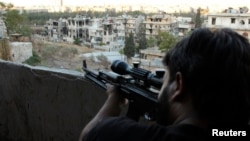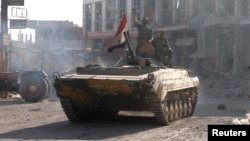BEIRUT —
Rebels battling to oust Syrian President Bashar al-Assad failed to take full advantage last week when the Army spread out its forces preparing for possible U.S. airstrikes, according to military analysts.
The Army’s troop redeployments gave the rebels with an opening to launch effective attacks, the analysts say, and their failure to seize the opportunity highlighted a lack of leadership and coordination. They say similar problems have plagued the rebels since they launched the uprising against the Assad regime two-and-a-half years ago.
When it looked as if the U.S. air strikes were imminent last week, key Syrian military units left their barracks and were dispersed among the civilian population and housed in schools and hospitals. The move to avoid struck by U.S. cruise missiles caused a lull in the Army’s ground offensive, say opposition activists.
But military analysts said there was no response from the rebels.
“One of the problems the opposition has is tied to command structure,” said Aram Nerguizian of the Center for Strategic and International Studies, a Washington D.C.-based think tank.
“If you take the four big [Free Syrian Army] brigades, you are talking on paper of 100,000 to 120,000 people, but they have a command and control and communications structure that is at the level of the First World War,” Nerguizian said. “The second problem is that they have manpower, but they don’t have a unified chain of command that allows them to do mass infantry assaults.”
As an example of what he’s talking about, Nerguizian notes that Syrian army garrisons inside rebel territory and defended by only a few hundred soldiers are able to hang on and defy assaults to overrun them.
Even highly prized targets have eluded the rebels for months in areas they dominate in the north. It took them over a year to seize the hotly contested Menagh air base near the northern city of Aleppo. The base finally fell this past summer.
Ineffective chain of command
On his appointment earlier this year to lead what is known as the rebel’s Supreme Military Command, Gen. Salim Idriss, a defector from the Syrian army, acknowledged he would face problems in shaping a chain of command capable of directing FSA brigades, whose commanders had been used to operating autonomously.
But little progress appears to have been made in overcoming the lack of coordination and in creating a unified and effective command structure, according to the experts.
Trying to mount a multi-brigade ground assault can takes days of tedious negotiations. That’s especially so when it involves units affiliated with jihadists such as al-Qaida.
Charles Lister of IHS Jane's Terrorism and Insurgency Center estimates the jihadists number about 10,000 mainly foreign fighters, and that Islamist militias are able to muster 20,000 to 35,000.
“The rebels have reverted back to their attrition tactics of one kill, one kill, one kill, hoping a trickle down effect will sap the morale of Assad forces,” says Nerguizian.
Making matters worse, military analysts note increased infighting between harder-line jihadists and Western-backed FSA rebel units. Earlier this year Al Qaeda fighters killed three FSA commanders in Latakia and Idlib.
Yezid Sayigh, a senior associate at the Carnegie Endowment’s Middle East Center, also notes the rebels have failed to develop a political strategy that could persuade Assad supporters to change sides or to push for peace negotiations.
“The rebels have lacked political leadership from the start,” Sayigh said. “I think sometimes the lack of unity among the rebels is over-stated by the West at the expense of the lack of a clear political strategy for getting to the end-goal.
“How do you go from here to where the regime can no longer prevent its own supporters and constituencies from saying we want a deal?” Sayigh asks.
Government has problems too
But the Syrian government also has its problems. According to Nerguizian, Assad’s military has tactical challenges it is struggling to overcome.
“You have the reality that they are not able to conduct as they would wish to combined armor and infantry assaults,” Nerguizian said. “Which is one of the reasons you have seen so many attacks with chemical weapons in the Damascus suburbs to make up for the shortfall.”
What has helped the Assad forces overcome their weaknesses has been the arrival on the battlefield of Hezbollah, the militant Lebanese Shi’ite movement.
Analysts estimate Hezbollah has fielded up to 10,000 experienced fighters and given the Assad regime the edge in key encounters such as the capture in June of the strategic town of Qusair on the Syrian-Lebanese frontier that had been in rebel hands for a year. Iraqi Shiite volunteers have also bolstered Assad’s forces.
The foreign fighters have helped train pro-Assad militiamen gathered in the
National Defense Force, which Nerguizian believes will loom as a bigger factor when it becomes better organized under Hezbollah tutelage.
The Army’s troop redeployments gave the rebels with an opening to launch effective attacks, the analysts say, and their failure to seize the opportunity highlighted a lack of leadership and coordination. They say similar problems have plagued the rebels since they launched the uprising against the Assad regime two-and-a-half years ago.
When it looked as if the U.S. air strikes were imminent last week, key Syrian military units left their barracks and were dispersed among the civilian population and housed in schools and hospitals. The move to avoid struck by U.S. cruise missiles caused a lull in the Army’s ground offensive, say opposition activists.
But military analysts said there was no response from the rebels.
“One of the problems the opposition has is tied to command structure,” said Aram Nerguizian of the Center for Strategic and International Studies, a Washington D.C.-based think tank.
“If you take the four big [Free Syrian Army] brigades, you are talking on paper of 100,000 to 120,000 people, but they have a command and control and communications structure that is at the level of the First World War,” Nerguizian said. “The second problem is that they have manpower, but they don’t have a unified chain of command that allows them to do mass infantry assaults.”
As an example of what he’s talking about, Nerguizian notes that Syrian army garrisons inside rebel territory and defended by only a few hundred soldiers are able to hang on and defy assaults to overrun them.
Even highly prized targets have eluded the rebels for months in areas they dominate in the north. It took them over a year to seize the hotly contested Menagh air base near the northern city of Aleppo. The base finally fell this past summer.
Ineffective chain of command
On his appointment earlier this year to lead what is known as the rebel’s Supreme Military Command, Gen. Salim Idriss, a defector from the Syrian army, acknowledged he would face problems in shaping a chain of command capable of directing FSA brigades, whose commanders had been used to operating autonomously.
But little progress appears to have been made in overcoming the lack of coordination and in creating a unified and effective command structure, according to the experts.
Trying to mount a multi-brigade ground assault can takes days of tedious negotiations. That’s especially so when it involves units affiliated with jihadists such as al-Qaida.
Charles Lister of IHS Jane's Terrorism and Insurgency Center estimates the jihadists number about 10,000 mainly foreign fighters, and that Islamist militias are able to muster 20,000 to 35,000.
“The rebels have reverted back to their attrition tactics of one kill, one kill, one kill, hoping a trickle down effect will sap the morale of Assad forces,” says Nerguizian.
Making matters worse, military analysts note increased infighting between harder-line jihadists and Western-backed FSA rebel units. Earlier this year Al Qaeda fighters killed three FSA commanders in Latakia and Idlib.
Yezid Sayigh, a senior associate at the Carnegie Endowment’s Middle East Center, also notes the rebels have failed to develop a political strategy that could persuade Assad supporters to change sides or to push for peace negotiations.
“The rebels have lacked political leadership from the start,” Sayigh said. “I think sometimes the lack of unity among the rebels is over-stated by the West at the expense of the lack of a clear political strategy for getting to the end-goal.
“How do you go from here to where the regime can no longer prevent its own supporters and constituencies from saying we want a deal?” Sayigh asks.
Government has problems too
But the Syrian government also has its problems. According to Nerguizian, Assad’s military has tactical challenges it is struggling to overcome.
“You have the reality that they are not able to conduct as they would wish to combined armor and infantry assaults,” Nerguizian said. “Which is one of the reasons you have seen so many attacks with chemical weapons in the Damascus suburbs to make up for the shortfall.”
What has helped the Assad forces overcome their weaknesses has been the arrival on the battlefield of Hezbollah, the militant Lebanese Shi’ite movement.
Analysts estimate Hezbollah has fielded up to 10,000 experienced fighters and given the Assad regime the edge in key encounters such as the capture in June of the strategic town of Qusair on the Syrian-Lebanese frontier that had been in rebel hands for a year. Iraqi Shiite volunteers have also bolstered Assad’s forces.
The foreign fighters have helped train pro-Assad militiamen gathered in the
National Defense Force, which Nerguizian believes will loom as a bigger factor when it becomes better organized under Hezbollah tutelage.









